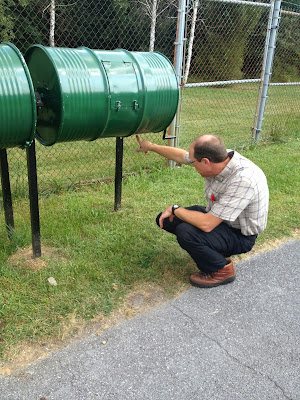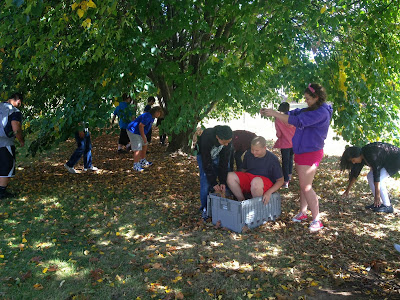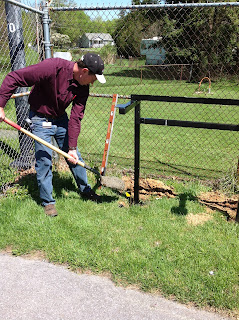We are finally back up and running (prepping food = kitchen waste) and making a new batch of compost. The batch from last year dried out over the summer so we emptied the barrel and added it to a dirt pile out back. In the following pictures Mr. Hering is checking out the barrels to assure they are working properly and to see if any adjustments can be made. We talked about adding some more vent holes to allow for proper aeration. We also looked at and discussed a few ways to make the screens for filtering the compost. Any large chunks will go back in to continue breaking down.
As you can see we are finally reaching high enough temperatures for the thermophiles to be doing their job breaking down the food scraps. The mixtures seems to be pretty wet this time around because we have a lot of food scraps, but not enough dry material. We added some of our lint from the dryers, some saw dust from the carpentry class, some shredded paper from our building, and we are going to collect some fallen leaves this week. After we add some dry material this week, we will lock it up and turn it occasionally, but we basically need to let it work it's magic now!!
More photos and updates to come once we have finished product.
Compost4Education
Living to Serve: Environmental Grants sponsored by CSX as a special project of the National FFA Foundation.
Monday, September 30, 2013
Wednesday, May 22, 2013
Last Wednesday we had a certified Master Composter (Martha Sullivan) come in and talk to us about the science behind composting and the state of our current composting system. She taught us so much about what actually happens during the composting process and gave us some great pointers as to how we could improve upon our composting process. We had the Landscaping students and the Culinary students together for her presentation so that we could all better understand and be a part of the entire process together.
This lesson also really inspired many of the students to try composting at their homes as well as composting here at CTC. We also discussed including materials from other classes in our building like sawdust from the Carpentry class (from untreated wood, of course), hair clippings from the Cosmetology class, and shredded paper from our school wide recycling program.
Here are some pictures of the guest speaker, her PowerPoint presentation, and students trying to turn the already very heavy barrels. She suggested that we completely fill our barrels so that they would build up enough heat to be considered a "hot" composting system which breaks down the larger materials MUCH faster than cold composting. Our barrels had way to much green material (nitrogen rich) which contain a lot of moisture, so we needed to add more brown/dry material (carbon rich) to even it out and get the proper balance for the process to happen quicker.


As we were looking at our current barrels we noticed that the maintenance crews were cleaning bird nests out of the street lights on the property, so we were able to use more of natures wonderful gifts to help accelerate our composting materials in the barrels.


We are learning so much and plan to adjust our whole system next year based on the information and feedback that we received from Mrs. Sullivan. We are excited to have her come back and visit again next year so we can show off our finished product and our re-vamped composting system.
The wild, wonderful world of composting!!
Just like we do, compost has these 5 basic needs:
Food, water, warmth, shelter, and air!!
And then you will end up with BLACK GOLD!!
Perfect planting material
This lesson also really inspired many of the students to try composting at their homes as well as composting here at CTC. We also discussed including materials from other classes in our building like sawdust from the Carpentry class (from untreated wood, of course), hair clippings from the Cosmetology class, and shredded paper from our school wide recycling program.
Here are some pictures of the guest speaker, her PowerPoint presentation, and students trying to turn the already very heavy barrels. She suggested that we completely fill our barrels so that they would build up enough heat to be considered a "hot" composting system which breaks down the larger materials MUCH faster than cold composting. Our barrels had way to much green material (nitrogen rich) which contain a lot of moisture, so we needed to add more brown/dry material (carbon rich) to even it out and get the proper balance for the process to happen quicker.


As we were looking at our current barrels we noticed that the maintenance crews were cleaning bird nests out of the street lights on the property, so we were able to use more of natures wonderful gifts to help accelerate our composting materials in the barrels.


We are learning so much and plan to adjust our whole system next year based on the information and feedback that we received from Mrs. Sullivan. We are excited to have her come back and visit again next year so we can show off our finished product and our re-vamped composting system.
The wild, wonderful world of composting!!
Just like we do, compost has these 5 basic needs:
Food, water, warmth, shelter, and air!!
And then you will end up with BLACK GOLD!!
Perfect planting material
Monday, May 6, 2013
We're making compost!!!
We have been using material from the culinary arts classes (food scraps) and material from the landscaping classes (dried leaves, flower petals & stems, and used soil) to mix in and help dry out the aging kitchen scraps from earlier in the year . . . and we have begun to fill the barrels!! It's very exciting to see the hard work of these 3 programs (Welding, Culinary, & Landscaping) here at CTC come together to create usable compostable materials!! Here are 2 beautiful pictures of what our compost currently looks like (we are still adding material to it everyday) and how the barrels look when in use. Thank you so very much to the students in the welding program for their awesome handy work & creative genius. And a big thank you to Mr. Hering for giving them the time to work on it!!
Take time to notice the metal rod that goes through the barrel to help break up and aerate the material inside the barrels. Also notice the opening they created in the barrel and how much forethought it required to add a metal lip to help eliminate any spillage or leakage issues. They really thought of everything. The hinges and the lock system definitely make this a high-end system that will hopefully last for many years to come.
Take time to notice the metal rod that goes through the barrel to help break up and aerate the material inside the barrels. Also notice the opening they created in the barrel and how much forethought it required to add a metal lip to help eliminate any spillage or leakage issues. They really thought of everything. The hinges and the lock system definitely make this a high-end system that will hopefully last for many years to come.
Thursday, May 2, 2013
Mounting the barrels
On Wednesday we finally had a break in the rainy weather here in Frederick so the welding students were able to touch up the post with a little spray paint and attach the barrels to the posts. They did a great job and they look amazing. I am impressed by how smoothly they move around and how well built they are. We plan to get compost in the tomorrow!!
Friday, April 26, 2013
THE POSTS ARE IN!!!
These are the posts that will ultimately hold the barrels. Mr.Herring and Spiro Millios set the posts on a rock base, mixed and added the concrete, and checked to make sure they were level. They set the posts Thursday after school and the plan is to let the concrete cure over the weekend. On Monday they will attach the barrels and we will finally add the kitchen scraps and being the composting process.
Sunday, April 14, 2013
Composting material
In the meantime in the Culinary Arts we have been saving LOTS of kitchen scraps for several months now. We have been keeping them in a 40 gallon trashcan, but finally filled that up a few weeks ago, so we split the scraps into two 40 gallon trashcans. When we went out as a class to inspect the compost it smelled awful and made people gag. It's would seem as though our compost has turned anaerobic due to lack of air, lack of movement or rotation, and having such a high moisture content. We added some leaves and some twigs to help dry it out, but obviously not enough. When we transfer some of the food scraps to the barrels the landscaping class will add some more dry material such as Peat moss and dried pine needles. Once in the barrels, the mixture should get proper air flow, reach the optimum temperature, and start to break down quickly. At least that is the plan! While turning the material we have in the trashcans I realized that we have some very large pieces of product in there and we need to be more careful in the future to break larger scraps down into smaller more manageable pieces.
Friday, April 12, 2013
Making the composting barrels
So production on the metal composting barrels has been delayed for various reasons (this is not a built in part of anyone's curriculum so it's done with precious spare time) Our materials were delayed by several months due to some red tape issues, so we are just about to finish up the barrels and hopefully get them set up within the next week. Here are some pictures of the progress of the two barrels and the posts that will hold them. All of this work has done by two very talented and motivated young men in the Welding/Ag Metals program here at CTC, Mitchell Bishop and Jared Harshman. For starters they had to cut an access door in the barrels, it's tough to make precise cuts because the barrels are round. Then they had to weld on hinges and metal flaps to make the door close properly. They fabricated and welded a spinning crank on the end of each barrel so it will turn properly once mounted on the posts. The posts were fabricated and painted before putting them in the ground. The barrels were also primed and painted before the final structure is assembled.
Subscribe to:
Comments (Atom)































